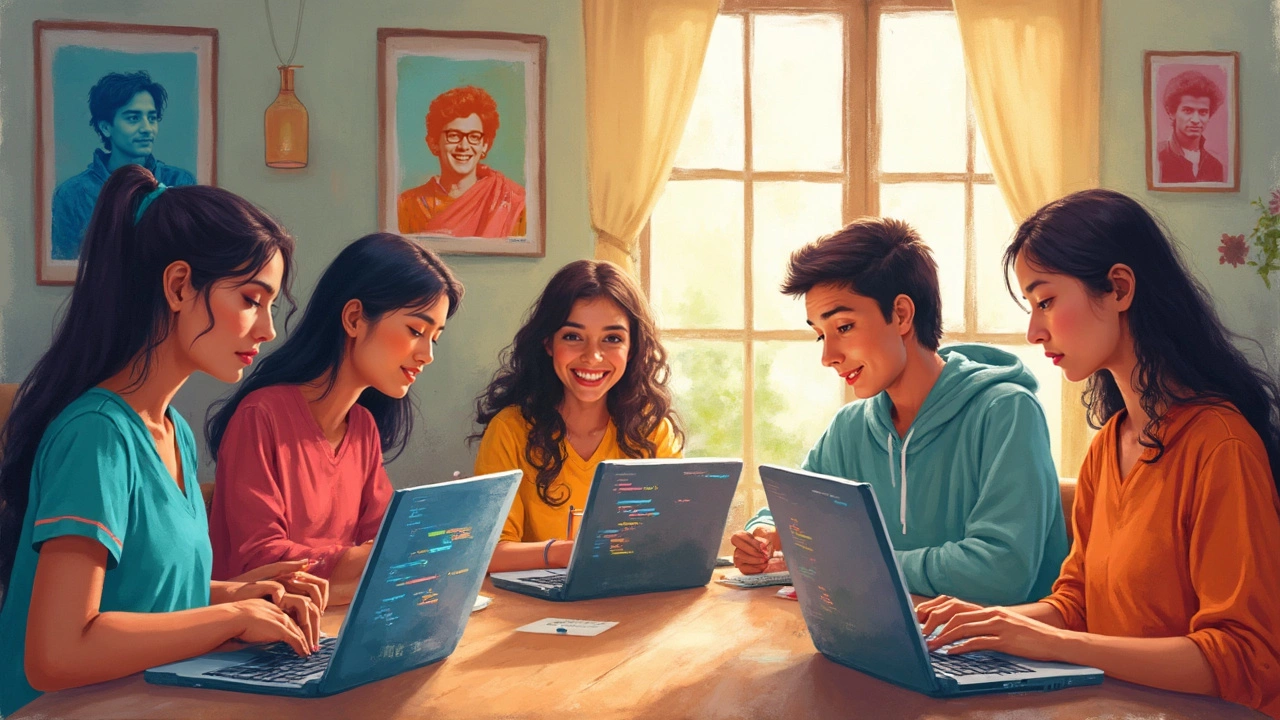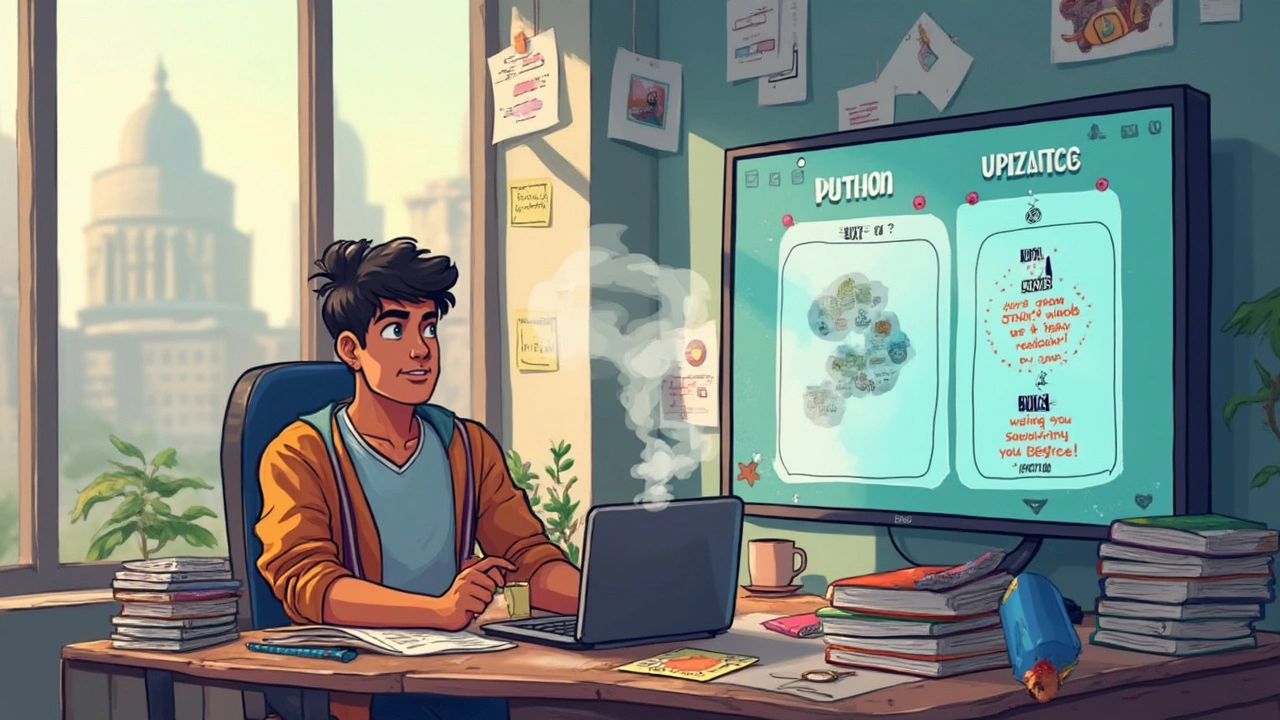
Ever tried to pick your first coding language and felt totally lost? You’re not alone. With hundreds of options and everyone claiming their favorite is “the best,” it’s confusing. What most people really want to know is: which coding language can a total beginner actually wrap their head around, and see progress in, without going nuts?
Here’s the good news: you don’t need to be a math whiz or a tech genius to get started. Some languages are built for beginners—they use words and structure that make sense even if you’ve never coded before. One big hint? If people use a language to teach kids, it’s probably friendly enough for grown-ups too.
Picking the right language isn’t just about making your life easy for a week or two. The simpler the start, the faster you’ll actually build something you care about, and the bigger your confidence boost. That early win can be the difference between sticking with coding or dropping it for good. So, what makes certain languages easier, and which ones give you that smooth on-ramp into the world of code? Let’s sort that out—in plain terms.
- What Makes a Coding Language Simple?
- Most Beginner-Friendly Languages
- Why Python Pops Up Everywhere
- Tips to Make Learning Coding Easier
What Makes a Coding Language Simple?
If you’re trying to figure out which language wins the title of simplest coding to learn, it’s good to know what actually makes one language easier than the next. We’re not talking about shortcuts or watered-down versions, but real languages that help you learn useful things right away.
Simple coding languages usually check a few important boxes:
- Easy-to-read syntax: They look like plain English instead of jumbled math formulas. When code matches the way we normally speak or write, it just clicks faster.
- Less setup, faster feedback: You don’t want to mess around setting up endless programs just to run one line of code. The best beginner languages let you start coding in minutes, and you see what your code does right away.
- Forgiving errors: Every newbie makes mistakes, so a beginner-friendly language gives you helpful error messages instead of cryptic, scary ones.
- Loads of resources: It’s way easier to stick with coding if there are tons of guides, forums, and tutorials—think YouTube crash courses, game-based lessons, or discussion boards packed with answers.
The table below shows how three popular languages for beginners score on these must-haves:
| Language | Readability | Setup Time | Beginner Support | Error Friendliness |
|---|---|---|---|---|
| Python | High | Low | Excellent | Very Friendly |
| JavaScript | Medium | Very Low | Good | Pretty Friendly |
| Scratch | Very High | Tiny (online) | Excellent | Super Friendly |
Simple doesn’t mean basic. Even professional software gets built on these languages. The main trick is that starting out feels less overwhelming, letting you focus on the creative part of coding instead of drowning in tech jargon. If you find something that checks most of these boxes, you’re already ahead of the game.
Most Beginner-Friendly Languages
If your goal is to pick up coding without banging your head against the wall, a few languages stand out for making life easier. The most famous on-ramp for beginners is Python. Why? Syntax is clean, code reads almost like English, and there’s less weird punctuation than in most other languages. Even a basic program like “hello world” in Python is just one line, compared to the five or six you’d need in something like Java.
Scratch is another superstar if you’re teaching younger kids or just want a visual, drag-and-drop way to see results fast. It lets you build animations and little games by snapping together colored blocks. Tons of schools use Scratch with kids as young as 8, which says a lot about how frustration-free it can be.
JavaScript is a go-to if you love the idea of making websites interactive. You can run it right in your browser—no weird installation steps—and see instant feedback. It’s a little wordier than Python, but basic stuff like buttons and popups are easy to pick up. Plus, JavaScript skills transfer straight into building real websites and apps people actually use.
Want a side-by-side look at how these languages compare for beginners? Check out this quick table:
| Language | Famous For | Typical Use | How Fast Can You Build Something? |
|---|---|---|---|
| Python | Easy syntax, lots of tutorials | Web apps, automation, data science | A few hours to a day |
| Scratch | Visual learning, drag & drop | Games, animation, teaching logic | Minutes |
| JavaScript | Runs in the browser, instant feedback | Websites, interactive apps | Less than a day |
No matter which you pick, the real trick is to start simple. Write a few lines, see what happens, and keep going. Coding is way less scary when you can see results right away.

Why Python Pops Up Everywhere
It’s impossible to google “simple programming language” and not see Python mentioned in the first three results. If you ask around in coding classes or online forums, folks almost always recommend Python as the simplest coding language to get started. But why does this language get so much attention?
First off, Python’s syntax is basically plain English. Look at the line print('Hello, world!')—even if you’ve never written code before, you can guess what it does. There are no curly braces, no weird punctuation puzzles. A lot of schools and beginner coding programs use Python because it’s so easy to read and write.
Python’s also super flexible. It’s used everywhere: web apps, simple games, automation scripts, data crunching, even artificial intelligence. Some of the biggest companies—Google, Netflix, NASA—run massive parts of their systems on Python. If you pick it up, you won’t run out of cool things to build.
And the best part? The Python community is massive. If you get stuck or have a dumb question (and trust me, we all do), there’s a mountain of answers on forums, YouTube, or sites like Stack Overflow. Someone’s probably had the same issue, and they’ve left a clear fix just a search away.
Take a look at these numbers to see what’s going on:
| Fact | Python | JavaScript | Java |
|---|---|---|---|
| First appeared | 1991 | 1995 | 1995 |
| TIOBE Index Rank (June 2025) | 1 | 7 | 4 |
| Lines to do "Hello, World!" | 1 | 1 | 3 |
| GitHub repositories (2024) | 4.65 million | 7.2 million | 5.3 million |
| Google search results for "learn [language]" | 1.5 billion | 1.1 billion | 0.9 billion |
With numbers like that, it makes sense why every beginner book, online course, and in-person bootcamp has a Python track. You’re backed by boatloads of tutorials and project ideas. Whether you want to automate boring tasks or train a tiny AI, Python helps you see results fast without making your head hurt.
Tips to Make Learning Coding Easier
Let’s be real—coding from scratch can get pretty overwhelming, especially if you try to learn everything at once. But you don’t have to go down that rabbit hole. The truth is, most beginners get stuck because they try to bite off too much. Here’s how to dodge those hurdles and make things simpler.
- Stick to One Language: Jumping between several languages seems tempting, but it’ll just confuse you. If you pick a beginner-friendly language like Python, focus on that until basic stuff feels easy. Once you’ve got the groove, then you can look around.
- Practice by Building Small Projects: Tutorials are great, but you’ll really learn when you try making your own things—like a calculator, a to-do list, or a simple game. Small wins add up fast.
- Follow a Structured Path: Tons of folks spin their wheels on random YouTube rabbit holes. Instead, choose one course or learning track and finish it before you jump ship. Sites like freeCodeCamp, Codecademy, and Khan Academy are built for clarity and slow, steady progress.
- Debugging Is Learning: If your code throws errors, don’t panic. Figuring out what went wrong is half the battle, and that’s where real learning sticks. Googling error messages is a rite of passage for every coder.
- Get Involved with Others: Coding communities and forums—think Stack Overflow, Reddit's r/learnprogramming, or Discord groups—are goldmines for support and advice. Someone’s probably already asked your question.
- Break Problems Into Chunks: Don’t try to write a big program all at once. Split problems into smaller pieces you can handle one by one.
Most people who start learning coding will quit in the first three months if they don’t see results. Consistent, even if it’s just twenty minutes a day, usually beats cramming for hours on Sundays.
| Language | Time to Build Basic Project | Community Resources |
|---|---|---|
| Python | 2 - 4 weeks | Huge |
| JavaScript | 3 - 6 weeks | Huge |
| Scratch | 1 - 2 weeks | High (for kids and teens) |
| Ruby | 3 - 5 weeks | Good |
Don’t forget—asking for help is normal in programming. Nobody figures it out alone, and even pros use Google or check the docs every single day. The best way to learn is to make things, mess up, get help, and try again. That’s how everyone who really learns stays motivated and eventually gets good at this.
